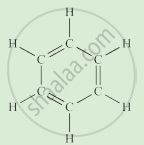Advertisements
Advertisements
प्रश्न
Distinguish between ionic and covalent compounds under the following properties:
(i) Strength of forces between constituent elements
(ii) Solubility of compounds in water
(iii) Electrical conduction in substances
उत्तर
(i) The forces of attraction between the constituent elements (positive and negative ions) of ionic compounds are stronger than the forces of attraction between the constituent elements of covalent compounds.
(ii) Ionic compounds are soluble in polar solvents such as water and are insoluble in non-polar solvents such as petrol, kerosene, etc.
Covalent compounds on the other hand dissolve readily in organic solvents such as alcohol and acetone, but are insoluble in polar compounds.
(iii) Ionic compounds conduct electricity in their molten state or aqueous form, whereas covalent compounds do not conduct electricity.
APPEARS IN
संबंधित प्रश्न
Write any three features and give two examples of covalent compounds
Name the black substance of pencil. Will the current flow through the electrical circuit when we use the sharpened ends of the pencil to complete the circuit?
What type of bonds are present in H2 molecule? Draw their electron-dot structures.
Give the formula of the compound that would be formed by the combination of the following pair of elements:
Al and Cl2
Draw the electron-dot structure of NH3 and state the type of bonding.
Explain the following term with example.
Covalent bond
Explain the following briefly.
Pure water does not conduct electricity, but on adding sodium chloride to it, it starts conducting electricity.
Explain the following briefly:
Cl2 is a non polar molecule, while HCl is a polar molecule.
(a) Compound X consists of molecules.
Choose the letter corresponding to the correct answer from the choices (a), (b), (c) and (d) given below
X is likely to have a :
An element L consists of molecules.
What type of bonding is present in the particles that make up L?
Draw an electron dot diagram to show the formation of the following compound.
Magnesium chloride [ H=1, C=6, Mg=12, Cl=17].
Explain the following:
Polar covalent compounds conduct electricity?
Write the molecular formula of the given compound.
Propylene
Complete the following activity.
Write the names of the hydrocarbons for the following structural formula.
(isobutylene, cyclohexane, propene, cyclohexene, cyclopentane, benzene, propyne, isobutane, propane)
 |
List two differences between the properties exhibited by covalent compounds and ionic compounds.
Identify the incorrect statement and correct them.
- Like covalent compounds, coordinate compounds also contain charged particles (ions). So they are good conductors of electricity.
- Ionic bond is a weak bond when compared to Hydrogen bond.
- Ionic or electrovalent bonds are formed by mutual sharing of electrons between atoms.
- Loss of electrons is called Oxidation and gain of electron is called Reduction.
- The electrons which are not involved in bonding are called valence electrons.
When ethyl alcohol and acetic acid are mixed, the resulting ester has a chemical formula ______.
A molecule of ammonia (NH3) has
Carbon can neither form C4- cation nor C4 anion. Why?
Explain dipole (polar) molecule by taking hydrogen chloride as an example.
